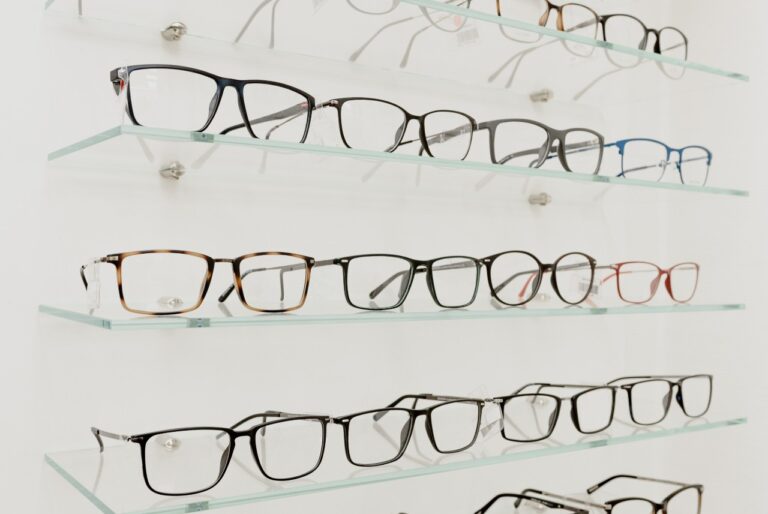
“Oh, my! Oh, my! This is so much more than I can bear … Can you please help me choose the perfect pair?”
Confused? You are not alone. Many people absolutely dread looking for a new pair of glasses, and end up delaying looking for a new pair until one day … their glasses break. If you have a low single vision prescription, you probably could get something in a day or so but if you have a higher prescription or need progressive lenses, you may be out of luck and have to wait a few days to get your new glasses. Here are 8 tips to help you find the perfect pair(s) of eyeglasses today!
- Where should I buy my glasses? Whether you need single vision, bifocal, trifocal, or progressive lens ~ make sure to visit a “registered” eyeglasses specialist, otherwise known as the optician, that you trust. He or she can best advise you as to what type of lens you require for your prescription. Don’t be afraid to ask questions and voice concerns. These professionals have been trained to measure and fit your eyeglasses correctly, and will ensure that your prescription is being filled to “regulated standards”. Just know that there is no obligation whatsoever to buy anywhere you don’t feel comfortable or feel pressured. Beware of places that operate without an optician on site ~ they are not operating according to the law.
- What shape or style should I choose? Choose a frame that flatters your face shape. Try as many glasses as you can to discover what works and doesn’t work, as well as what you like or don’t like. Keep the scale of the frame in relation to your bone structure and height. Avoid trendy styles that will be out of fashion by next season. Remember: big frames on a small person will overpower your face, bone structure or stature ~ it will look like the glasses are wearing you instead of you wearing the glasses. And vice-versa, a small and delicate frame on someone who has a bigger bone structure and taller stature will look out of place and create the “Shrek” look … not so great on real people.
- What colour should I choose? Fair people with light to medium hair colour will look best in light to medium neutrals such as medium grey, taupe, camel, steel gray, or light brown. Dark hair or dark complexion can handle darker frames such as black, dark brown, deep wine, dark olive, and tortoise. Here’s a secret of the trade: Keep in mind the value of your hair ~ how light or dark is your hair colour? On a scale of 1 (black) to 10 (white) ~ what number would it be? Then, repeat the same lightness or darkness in your frame. However, why limit yourself to one basic neutral? Eyeglasses are available in so many beautiful colours and colour combinations today ~ choose your favourite and best colour and have fun! If you have no clue what colours look best on you, consider having a colour analysis done by yours truly ~ it will save you tons of frustration, time and money plus you’ll have fun while doing it.
- How many pairs should I have? Just like you would have more than one pair of shoes to wear with different outfits or occasions ~ you should own at least 2 pairs of eyeglasses. In fact, if you are a full-time eyeglasses wearer, I highly recommend that you build an “eyeglasses wardrobe” overtime to give you different options on a day-to-day basis. You spent a lot of time on the computer, consider getting a pair of glasses specially designed for computers. Perhaps you are an electrician that needs a trifocal lens with a reading zone at the top because of your job’s demands. You love reading and find the reading zone too limiting in your progressive lens, get prescription reading glasses. You favour a specific sport, consider prescription sport eyeglasses. If, on the other hand, dressy social events or galas are part of your lifestyle, why not have some fun and buy a dressier pair with rhinestones or something that totally express your funky personality side. In the end, owning more than one pair puts less wear and tear on the one pair, gives you a change of pace, provides a different look for different outfits or occasions in your life, and allows you to express your personality styles!
- What are progressive lenses? Progressive lenses correct more than one vision at a time without the visible segment lines seen in bifocal or trifocal lenses. The advantage of progressive lenses is that it allows the wearer to see clearly at all distances. This is the one area where I recommend buying the highest quality possible! If price is an issue, choose a more affordable frame instead of buying an expensive designer frame, and buy higher quality progressive lenses. You will not regret it. Progressive lenses have improved greatly over the years. New technology has brought us the “Free Form Lens” often referred to as the “Digital” Lens. They not only provide a better and wider field of vision but also reduce the distortion between all zones, thus creating a smoother and comfortable transition between distance and near portions of the lens. If in doubt, it is best to talk to your optician.
- Should I put Anti-Reflective Coatings? Definitely! First of all, anti-reflective coatings have proven to dramatically reduce glare as well as reduce eyestrain caused by overhead lighting or computers. AR coatings reduce reflections that mask your eyes from a clear, complete view when someone is looking at you ~ known in the industry as the “window effect”. Last but not least, you will also feel more comfortable driving at night because AR coatings reduce glare from headlights from other vehicles or the rain. From an image perspective, wearing eyeglasses in general create a “physical barrier” between you and the viewer. AR coatings not only reduce the “window effect” but also lessen the “physical barrier” that can make you look like you are hiding behind something or hiding something. It helps you project the image of someone who is more trustworthy and puts others more at ease because it allows people to actually see your eyes instead of just reflections. Plus, AR coatings make the lenses appear thin or non-existent and your eyes look more natural. AR coatings are highly recommended for anyone in business, making regular TV appearances, in the public eye or picture taking ~ but truthfully, all eyeglasses wearers benefit from anti-reflective coatings.
- Why should I bother buying (prescription) sunglasses? Buying sunglasses is more than just a fashion statement. According to research “Protection against harmful ultraviolet (UV) light is essential to prevent possible damage to the eyes. As UV levels continue to rise and cause a host of eye problems, UV-blocking lenses and other prevention strategies remain key.” A good quality pair of sunglasses or prescription sunglasses is a must to protect your eyes from damaging UV and sun exposure. Beside, nothing says “cool” like a great pair of sunglasses. What style, colour or size should you choose for your sunglasses? Follow the same guidelines as you would for your regular glasses. However, sunglasses can be bigger than you regular pair (but watch that scale) and do not have to be boring ~ this is a great opportunity to express the wilder side of your personality.
- How can I darken the lenses for my sunglasses? There are 3 ways to darken your lenses: Tint, Polarization or Transitions. A tint reduces the amount of light that reaches the eye but does not reduce glare. Therefore, I recommend adding the AR coating in the back of your lenses if your budget allows it. Colour of the tint is a personal choice and doesn’t affect how well the lenses protect your eyes from UV light. Polarized lenses reduce reflected glare from surrounding waters, and have been used by boaters and fishermen for many years. The popularity of these types of sunglasses has soared and many others who spend time outdoors have discovered the benefits of polarized lenses. These sunglasses can be used for driving and, in fact, can reduce glare from a long surface such as the hood of a car or the road’s surface. Transitions lenses are also available and have improved tremendously over the years. Transitions Technology allows rapid darkening when you go outside (and rapid return to clear when you go in) and UV protection. If switching between your regular glasses and sunglasses does not appeal to you, Transitions are a great option ~ it’s like having 2 pairs in one. One last option for sunglasses is to order customized Clip-ons or choose a frame that has Clip-ons.
On a final note: Whether you do a tint, polarization, transitions or clip-ons ~ make sure the lenses block UVA and UVB between 290 and 400nm (UV400) for best protection.


